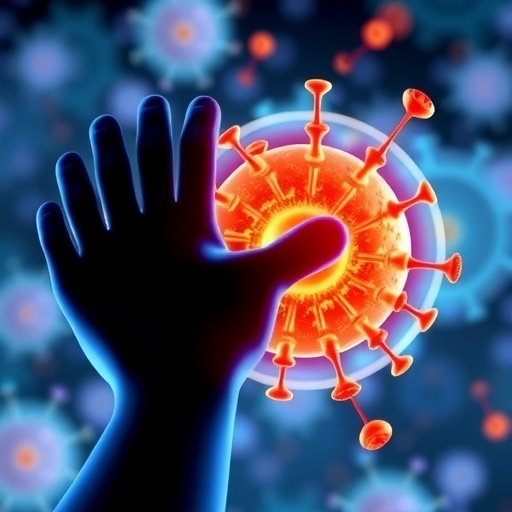Scientists at the University of Cambridge have unveiled a groundbreaking approach to cancer immunotherapy that promises to drastically enhance both the precision and safety of treatments targeting the immune system. This novel method centers on the strategic activation of the STING pathway—a crucial innate immune sensor within cells that orchestrates powerful immune responses against malignancies. Unlike existing therapies, which often suffer from unintended activation in healthy tissues leading to severe side effects, this new design ensures that immune activation occurs exclusively within the tumor microenvironment, heralding a new era of targeted immunomodulation.
The STING (Stimulator of Interferon Genes) pathway functions as a cellular alarm, detecting cytosolic DNA and catalyzing a cascade that results in the production of type I interferons and other cytokines. These molecules mobilize immune cells to identify and eliminate aberrant cells such as tumors. However, therapeutic agents developed to activate STING directly have historically struggled with systemic toxicity. Such drugs can inadvertently trigger excessive immune responses in healthy organs, potentially causing inflammation, tissue damage, or life-threatening conditions. This limitation has constrained the clinical success of STING agonists despite their potent anti-cancer properties.
To address this fundamental challenge, the Cambridge team engineered an innovative two-component prodrug system. Each component on its own is inert and non-toxic, designed to remain inactive as they circulate through the body. The breakthrough lies in their programmed activation only upon encountering a specific biochemical signature that is predominantly present in tumor tissues: the enzyme β-glucuronidase. This enzyme is scarce in normal tissues but enriched within the tumor microenvironment due to abnormal cellular turnover and infiltration by immune cells. When the “caged” prodrug component meets β-glucuronidase, the enzyme cleaves a protective chemical group, releasing the reactive species that can then rapidly bind with the second prodrug component.
This controlled interaction between the two components triggers the synthesis of a potent STING agonist exclusively within the tumor milieu. The chemical design utilizes molecular recognition principles, ensuring that the two elements find each other efficiently and react swiftly to form the active compound. By restricting activation spatially, the therapy confines immune system stimulation to cancerous tissues, preserving vital organs such as the liver, kidneys, and heart from off-target drug effects. This spatial precision could overcome the significant toxicity barriers that have hampered previous STING-based therapeutic attempts.
Preclinical evaluations demonstrate the elegance and effectiveness of this chemical strategy. In laboratory cell cultures, the individual prodrug components exhibited negligible biological activity, confirming their safety profile before activation. But under conditions mimicking the tumor microenvironment, where β-glucuronidase is abundant, the active STING agonist formed rapidly, triggering robust immune signaling even at very low concentrations. The team extended these findings to in vivo zebrafish and murine cancer models genetically engineered to express high levels of β-glucuronidase. The dual-prodrug system selectively activated STING in tumor tissues, eliciting strong anti-tumor immune responses while sparing healthy organs from toxicity.
Published in the prestigious journal Nature Chemistry, this research marks a significant advance in cancer drug development. The simplicity and modularity of the two-component prodrug system circumvent the need for complex molecular engineering or external triggers commonly employed in prodrug designs. Instead, the therapy leverages naturally occurring enzymatic activity unique to tumors to unlock its full potency, representing an elegant fusion of chemical biology and immunotherapy. This paradigm shift underscores how careful molecular tuning can refine immune activation, minimizing collateral tissue damage.
Beyond oncology, the implications of this strategy are far-reaching. Many diseases—ranging from infectious conditions to autoimmune disorders—require potent therapeutic agents that risk systemic side effects if administered non-specifically. The principle of delivering separate, biologically inert precursors that only assemble into an active drug within pathological environments could be broadly transformative. Medicines designed using this approach could offer unprecedented safety profiles, enhancing patient compliance and expanding treatment options across multiple medical fields.
Professor Gonçalo Bernardes, who led the study at Cambridge’s Yusuf Hamied Department of Chemistry, likens the approach to “sending two safe packages into the body that only unlock and combine when they meet the tumor’s unique chemistry.” This metaphor captures the essence of a strategy that intelligently leverages nature’s own biochemical signals to direct sophisticated chemical reactions in situ. Professor Bernardes emphasizes that such innovations not only advance cancer immunotherapy but also redefine how medicinal chemists think about drug activation and delivery.
The first author, Nai-Shu Hsu, stresses the broader impact of their discovery, highlighting that this method introduces a new way of conceptualizing drug safety and precision. By ensuring that STING activation—and thus immune response—is tightly localized, this technology may avoid the autoimmune-like toxicities that have plagued previous immune-targeting therapies. This is especially critical for chronic or combination treatments where cumulative side effects limit dosing and efficacy.
Financially supported in part by the Cambridge Trust and Alzheimer’s Research UK, the research also benefits from interdisciplinary collaboration among chemists, immunologists, and clinicians. Such alliances are vital to translating chemical innovations into clinically applicable therapies. As the Cambridge team continues to refine their prodrug system and explore its efficacy in various cancer types and complex biological models, the medical community awaits a new class of immune modulators with the potential to revolutionize cancer care.
In sum, this pioneering two-component prodrug approach to STING activation exemplifies the power of integrating chemical ingenuity with deep biological insight. It offers a technically sophisticated yet pragmatic solution to a longstanding obstacle in immunotherapy: how to unleash the immune system’s full anti-cancer potential without collateral harm. Given the compelling preclinical data and mechanistic clarity, this chemistry-driven innovation is poised to become a cornerstone for the next generation of precision medicines.
Subject of Research: Targeted activation of the STING immune pathway in cancer therapy via a two-component prodrug system
Article Title: Tumour-specific STING agonist synthesis via a two-component prodrug system
News Publication Date: 16-Sep-2025
Web References:
10.1038/s41557-025-01930-9
Keywords: Drug design, Cancer, Tumor cells, Drug combinations, Immune system




